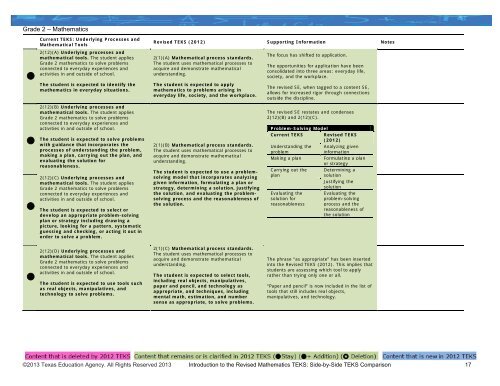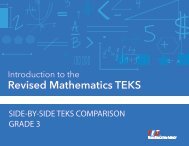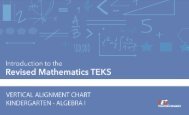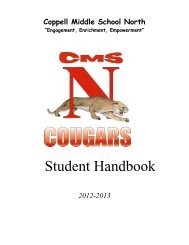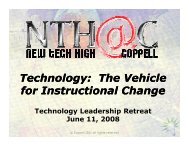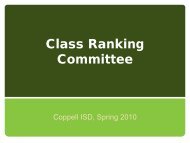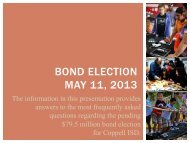Grade 2 - Coppell Independent School District
Grade 2 - Coppell Independent School District
Grade 2 - Coppell Independent School District
- No tags were found...
You also want an ePaper? Increase the reach of your titles
YUMPU automatically turns print PDFs into web optimized ePapers that Google loves.
<strong>Grade</strong> 2 – MathematicsCurrent TEKS: Underlying Processes andMathematical ToolsRevised TEKS (2012) Supporting Information Notes2(12)(A) Underlying processes andmathematical tools. The student applies<strong>Grade</strong> 2 mathematics to solve problemsconnected to everyday experiences andactivities in and outside of school.The student is expected to identify themathematics in everyday situations.2(12)(B) Underlying processes andmathematical tools. The student applies<strong>Grade</strong> 2 mathematics to solve problemsconnected to everyday experiences andactivities in and outside of school.The student is expected to solve problemswith guidance that incorporates theprocesses of understanding the problem,making a plan, carrying out the plan, andevaluating the solution forreasonableness.2(12)(C) Underlying processes andmathematical tools. The student applies<strong>Grade</strong> 2 mathematics to solve problemsconnected to everyday experiences andactivities in and outside of school.The student is expected to select ordevelop an appropriate problem-solvingplan or strategy including drawing apicture, looking for a pattern, systematicguessing and checking, or acting it out inorder to solve a problem.2(1)(A) Mathematical process standards.The student uses mathematical processes toacquire and demonstrate mathematicalunderstanding.The student is expected to applymathematics to problems arising ineveryday life, society, and the workplace.2(1)(B) Mathematical process standards.The student uses mathematical processes toacquire and demonstrate mathematicalunderstanding.The student is expected to use a problemsolvingmodel that incorporates analyzinggiven information, formulating a plan orstrategy, determining a solution, justifyingthe solution, and evaluating the problemsolvingprocess and the reasonableness ofthe solution.The focus has shifted to application.The opportunities for application have beenconsolidated into three areas: everyday life,society, and the workplace.The revised SE, when tagged to a content SE,allows for increased rigor through connectionsoutside the discipline.The revised SE restates and condenses2(12)(B) and 2(12)(C).Problem-Solving ModelCurrent TEKS Revised TEKS(2012)Understanding theproblemMaking a planCarrying out theplanEvaluating thesolution forreasonablenessAnalyzing giveninformationFormulating a planor strategyDetermining asolutionJustifying thesolutionEvaluating theproblem-solvingprocess and thereasonableness ofthe solution2(12)(D) Underlying processes andmathematical tools. The student applies<strong>Grade</strong> 2 mathematics to solve problemsconnected to everyday experiences andactivities in and outside of school.The student is expected to use tools suchas real objects, manipulatives, andtechnology to solve problems.2(1)(C) Mathematical process standards.The student uses mathematical processes toacquire and demonstrate mathematicalunderstanding.The student is expected to select tools,including real objects, manipulatives,paper and pencil, and technology asappropriate, and techniques, includingmental math, estimation, and numbersense as appropriate, to solve problems.The phrase “as appropriate” has been insertedinto the Revised TEKS (2012). This implies thatstudents are assessing which tool to applyrather than trying only one or all.“Paper and pencil” is now included in the list oftools that still includes real objects,manipulatives, and technology.©2013 Texas Education Agency. All Rights Reserved 2013 Introduction to the Revised Mathematics TEKS: Side-by-Side TEKS Comparison 17


